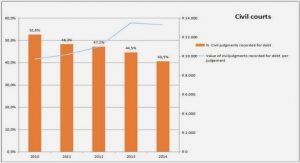Get Complete Project Material File(s) Now! »
Lower birth rate
According to the projections by Kinghorn et al (2002: 13), one outcome of the AIDS pandemic is that by 2015 the population of Botswana is expected to have diminished by about a quarter. This demographic development will result in the number of pupils of school-going age being far less than it would otherwise have been. Kelly (2000: 48) and Kinghorn et al (2002: 13) include two HIV and AIDS-related elements that would decrease demand for education. Consequently if HIV and AIDS are not controlled, there are likely to be fewer children born because: 66 it is now known that HIV impairs a woman’s fertility, resulting in an infected woman bearing twenty per cent fewer children than usual; and of the premature death of women in their child-bearing years (15-49 years).
Mother-to-child transmission of HIV
Children born to HIV-infected women who are not on ARVs have about a thirty per cent chance of being infected with HIV. Without ARV most of these infected children will die before they reach the age of five, many within the first two years of life. With regard to mother-to-child transmission of HIV, the Botswana Government has, since 2002, been providing free AZT (Azidothymidine) and Nevirapine to all HIV-positive pregnant women in order to minimise the transmission of HIV to the child (Status of the 2002 national response to the United Nations General Assembly Special Session [UNGASS], 2003: 24). It is believed that this programme can reduce mother-to-child transmission by up to fifty per cent (Botswana 2003 Second Generation HIV and AIDS Surveillance, 2003: 44). It is hoped that more women now have access to the PMTCT programme in 2002 so that fewer children are born with HIV. If this is the case, then the demand for education could be higher than supposed.
MITIGATING THE EFFECTS OF HIV AND AIDS ON THE INFECTED AND
AFFECTED LEARNERS In this section examines ways of dealing with the effects of HIV and AIDS on the demand for education, highlighted in sections 2.5.1.2 and 2.5.1.4, are investigated. In this discussion the mitigating strategies are specifically addressing the effects of HIV and AIDS on the infected and the affected learners. (The term infected learners refers to those who are HIV positive or are suffering from AIDS. Affected learners refer to those who are suffering as a result of their parents, guardians or siblings suffering from AIDS or its effects or have died). The triangular management approach which involves coping with the effects of HIV and AIDS is considered, caring for OVC and preventing the spread of HIV and AIDS. It should be mentioned that issues of lower birth rate and mother-to-child transmission of HIV (see sections 2.5.2.1 & 2.5.2.2) will not be considered because they require medical solutions.
The strategic management process
Figure 3.1 represents a strategic management process. This management process combines two elements – the strategic planning and operational management processes. The operational management aspect is essential as it deals with the day-to-day activities which are related to the implementation of the strategic plan. The operational management process involves strategic implementation, evaluation and control (Alkhafaji, 2003: 45). In contrast, the strategic planning aspect comprises the mission statement, environmental scanning, identification of strategic issues, and of strategic objectives, strategy formulation and finally the strategic plan. It is important to understand the process of strategic management so that the discussion of strategic planning can be put in perspective.
The relationship between strategic planning and strategic management
The term ‘strategic planning’ has already been explained in section 3.2.3. The following discussion explains the term ‘strategic management”. Management refers to the art or skill of directing and guiding the activities of other people in an organisation in such a manner that the stated goals are achieved in the best and most economical way (Cunningham & Cordeiro, 2003: 8-9). Therefore, the purpose of management is to serve an organisation by getting work done through people. The process of managing is partly based on the implementation of the strategies that the organisation sets. Stated differently, strategies become management practices (Cook, 2000: 13).
TABLE OF CONTENTS
- CHAPTER ONE ORIENTATION
- 1.1 INTRODUCTION
- 1.2 BACKGROUND OF THE STUDY
- 1.2.1 Prevalence of HIV and AIDS amongst the youth and employees in the education Sect
- 1.2.2 Stakeholder involvement
- 1.3 STATEMENT OF THE PROBLEM
- 1.4 THE SUBQUESTIONS
- 1.5 AIMS OF THE RESEARCH
- 1.6 MOTIVATION FOR THE RESEARCH
- 1.7 RESEARCH DESIGN AND METHODS
- 1.7.1 Design
- 1.7.2 Methodology
- 1.7.2.1 Literature study
- 1.7.2.2 Empirical research
- 1.8 PILOT STUDY ON THE QUESTIONNAIRE
- 1.9 DEFINITION OF TERMS
- 1.10 CHAPTER DIVISION
- 1.11 CONCLUSION
- CHAPTER TWO THE IMPACT OF HIV AND AIDS ON EDUCATION MANAGEMENT AND INTERVENTION STRATEGIES CONCERNING ITS EFFECTS
- 2.1 INTRODUCTION
- 2.2 BACKGROUND TO “HIV”/ “AIDS” AND ITS EFFECT ON HUMAN HEALTH
- 2.2.1 The meanings of “HIV”/ “AIDS” and how HIV can be transmitted
- 2.2.2 How HIVirus works in the human body
- 2.2.3 Clinical manifestations of AIDS
- 2.3 THE IMPACT OF HIV AND AIDS ON THE SUPPLY OF EDUCATION
- 2.3.1 Increased morbidity and mortality amongst the teachers and other educationrelated personnel
- 2.3.2 Increased absenteeism amongst teachers and other educationrelated personnel
- 2.3.3 Stress amongst teachers and other educationrelated personnel
- 2.3.3.1 Definition of the term “stress”
- 2.3.3.2 HIV and AIDS as a source of stress for teachers and other educationrelated personnel
- 2.3.3.3 Effects of stress
- 2.3.4 Workplacerelated effects of HIV and AIDS
- 2.3.5 Financial concerns
- 2.3.6 Undermined teacher training programmes
- 2.4 ADDRESSING THE EFFECTS OF HIV AND AIDS ON TEACHERS AND OTHER EDUCATIONRELATED PERSONNEL
- CHAPTER THREE STAKEHOLDER INVOLVEMENT IN STRATEGIC PLANNING
- 3.1 INTRODUCTION
- 3.2 THE NATURE OF STRATEGIC PLANNING
- 3.2.1 Strategy
- 3.2.2 Planning
- 3.2.3 Strategy and planning: Strategic planning
- 3.2.4 The strategic management process
- 3.2.5 The relationship between strategic planning and strategic management
- 3.3 MODELS OF STRATEGIC PLANNING IN EDUCATION
- 3.3.1 Political model
- 3.3.2 Consensual model
- 3.4 APPROACHES TO CONSENSUAL STRATEGIC PLANNING
- 3.4.1 Stakeholder management approach
- 3.4.2 The “geteverybodyinthesameroom” approach
- 3.4.3 Strategic issue management approach
- 3.5 INVOLVING STAKEHOLDERS IN STRATEGIC PLANNING
- 3.5.1 Rationale for stakeholder involvement in strategic planning
- 3.5.2 Prerequisites for involving stakeholders in strategic planning
- 3.5.3 Identifying stakeholders
- 3.5.4 Influence of stakeholder management issues on strategic planning
- 3.5.4.1 Inducementcontribution exchanges
- 3.5.4.2 Individual political behaviour
- 3.6 THE VALUE AND SHORTCOMINGS OF THE SELECTE STAKEHOLDERS WITH REGARD TO THEIR INVOLVEMENTIN A STRATEGIC PLAN IN EDUCATION
- 3.7 CONCLUSION
- CHAPTER FOUR RESEARCH DESIGN
- CHAPTER 5 RESULTS AND DISCUSSION
- CHAPTER 6 LIMITATIONS, FINDINGS, CONCLUSIONS AND RECOMMENDATIONS
EDUCATIONAL MANAGEMENT Project Topics






